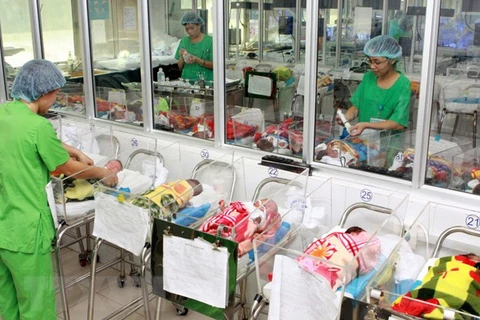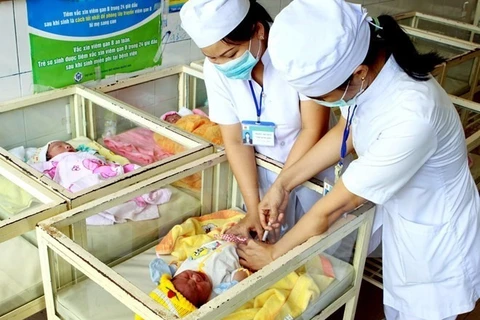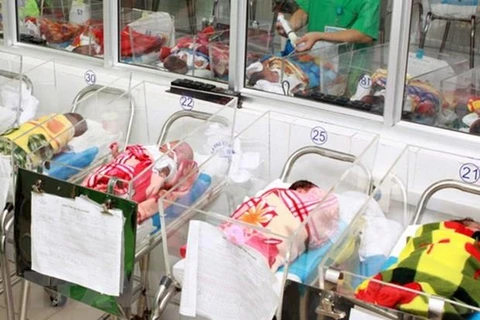Hanoi (VNS/VNA) - As Vietnam is listed among three countries with the highest rate of sex ratio imbalance at birth, local authorities are making efforts to raise public awareness and tighten regulations to shorten the gap.
According to the latest report on the world’s population conducted by United Nations Population Fund (UNFPA), Vietnam’s imbalance rate in 2019 was 111.5 boys per 100 girls, behind only China and India - the two most populous countries in the world.
Vietnam has faced a sex ratio imbalance at birth since 2006.
Pham Vu Hoang, deputy head of General Office for Population and Family Planning, said the imbalance started in Vietnam late but has increased faster than in other Asian countries.
In 2006, the country's sex ratio at birth started to exceed normal levels (104-106 boys to 100 girls). That ratio increased to 111.2 boys in 2010 and 112.8 boys in 2015. The increase was different between urban and rural areas and among regions.
The general population and housing census in 2019 showed the ratio was higher in rural areas than urban. The Red River Delta in the north had the highest level of imbalance.
Ha Thi Quynh Anh, a gender and human right specialist from the UNFPA, attributed the sex imbalance at birth in Vietnam to biased gender selection.
Many families in Vietnam prefer sons to inherit the home when parents have died and take over ancestor worship. Men are believed to be stronger than women so sons are trusted to work and take care of parents when they get old.
Many families abuse the development of technology to select their children’s gender. Decreased family size has forced parents to choose to have at least one son, she said.
Those reasons resulted in 40,800 unborn girls in Vietnam each year. This figure is calculated based on the difference between the estimated number of girls born following natural laws and the actual number of girls born in a year, Anh said.
International and Vietnamese studies have shown that sex imbalance at birth can lead to unpredictable consequences for society, the economy and political security.
There will be more men at marriage age than women, breaking the family structure, Pham Vu Hoang, deputy head of the General Office for Population and Family Planning said.
International experts have predicted that if the sex imbalance at birth is not controlled, by 2050, Vietnam will have a surplus of about 2.3 to 4.3 million men. That leads to some men having to marry late and many of them being unable to.
The increase in the sex ratio at birth also increases inequality such as the early marriage of women, increasing rate of divorce and remarriage of women, gender violence and woman trafficking, Hoang said.
UNFPA expert Ha Thi Quynh Anh said biased gender selection will put women under pressure to give birth to sons, leading to abortion or multiple births until they have a boy. This affects the physical, mental, reproductive and sexual health of women. Men will find it difficult to look for a partner to marry when they mature, especially men with low education, from poor families or who live in disadvantaged areas.
Vietnam has not felt the consequences of sex ratio imbalance at birth yet, but experiences from China and India show the consequences. Vietnam needs proper policies to respond to the problem, she said.
Raising public awareness
To control the sex ratio imbalance at birth, Vietnam adopted a project in the 2016-25 period which focuses on raising public awareness and encouraging the involvement of agencies, social organisations and the community to take action.
It aims to pull down the imbalance to a natural ratio of below 109 boys per 100 girls by 2030.
Taking effect from next month, violations in counselling methods to obtain the desired sex of a fetus will face tougher punishments, he said.
UNFPA expert Ha Thi Quynh Anh recommended Vietnam pay attention to communication to change social norms towards gender equality by putting gender education in the school curriculum.
To change social norms on gender, Vietnam should focus on changing public behaviours through communication channels to remove gender stereotypes and build new gender norms.
“We need to build positive male and female models as well as new gender standards in the family. For example, men are willing to share the chores with women; women can do jobs previously thought only to be able to be done by men. Children can take the mother's surname or sons and daughters have equal inheritance rights.”
Vietnam needs to promote men's participation in gender equality and violence prevention against women and girls. We should put forward social protection policies for the elderly to eliminate the thought of having a son to rely on in old age, she said./.
According to the latest report on the world’s population conducted by United Nations Population Fund (UNFPA), Vietnam’s imbalance rate in 2019 was 111.5 boys per 100 girls, behind only China and India - the two most populous countries in the world.
Vietnam has faced a sex ratio imbalance at birth since 2006.
Pham Vu Hoang, deputy head of General Office for Population and Family Planning, said the imbalance started in Vietnam late but has increased faster than in other Asian countries.
In 2006, the country's sex ratio at birth started to exceed normal levels (104-106 boys to 100 girls). That ratio increased to 111.2 boys in 2010 and 112.8 boys in 2015. The increase was different between urban and rural areas and among regions.
The general population and housing census in 2019 showed the ratio was higher in rural areas than urban. The Red River Delta in the north had the highest level of imbalance.
Ha Thi Quynh Anh, a gender and human right specialist from the UNFPA, attributed the sex imbalance at birth in Vietnam to biased gender selection.
Many families in Vietnam prefer sons to inherit the home when parents have died and take over ancestor worship. Men are believed to be stronger than women so sons are trusted to work and take care of parents when they get old.
Many families abuse the development of technology to select their children’s gender. Decreased family size has forced parents to choose to have at least one son, she said.
Those reasons resulted in 40,800 unborn girls in Vietnam each year. This figure is calculated based on the difference between the estimated number of girls born following natural laws and the actual number of girls born in a year, Anh said.
International and Vietnamese studies have shown that sex imbalance at birth can lead to unpredictable consequences for society, the economy and political security.
There will be more men at marriage age than women, breaking the family structure, Pham Vu Hoang, deputy head of the General Office for Population and Family Planning said.
International experts have predicted that if the sex imbalance at birth is not controlled, by 2050, Vietnam will have a surplus of about 2.3 to 4.3 million men. That leads to some men having to marry late and many of them being unable to.
The increase in the sex ratio at birth also increases inequality such as the early marriage of women, increasing rate of divorce and remarriage of women, gender violence and woman trafficking, Hoang said.
UNFPA expert Ha Thi Quynh Anh said biased gender selection will put women under pressure to give birth to sons, leading to abortion or multiple births until they have a boy. This affects the physical, mental, reproductive and sexual health of women. Men will find it difficult to look for a partner to marry when they mature, especially men with low education, from poor families or who live in disadvantaged areas.
Vietnam has not felt the consequences of sex ratio imbalance at birth yet, but experiences from China and India show the consequences. Vietnam needs proper policies to respond to the problem, she said.
Raising public awareness
To control the sex ratio imbalance at birth, Vietnam adopted a project in the 2016-25 period which focuses on raising public awareness and encouraging the involvement of agencies, social organisations and the community to take action.
It aims to pull down the imbalance to a natural ratio of below 109 boys per 100 girls by 2030.
Taking effect from next month, violations in counselling methods to obtain the desired sex of a fetus will face tougher punishments, he said.
UNFPA expert Ha Thi Quynh Anh recommended Vietnam pay attention to communication to change social norms towards gender equality by putting gender education in the school curriculum.
To change social norms on gender, Vietnam should focus on changing public behaviours through communication channels to remove gender stereotypes and build new gender norms.
“We need to build positive male and female models as well as new gender standards in the family. For example, men are willing to share the chores with women; women can do jobs previously thought only to be able to be done by men. Children can take the mother's surname or sons and daughters have equal inheritance rights.”
Vietnam needs to promote men's participation in gender equality and violence prevention against women and girls. We should put forward social protection policies for the elderly to eliminate the thought of having a son to rely on in old age, she said./.
VNA
























